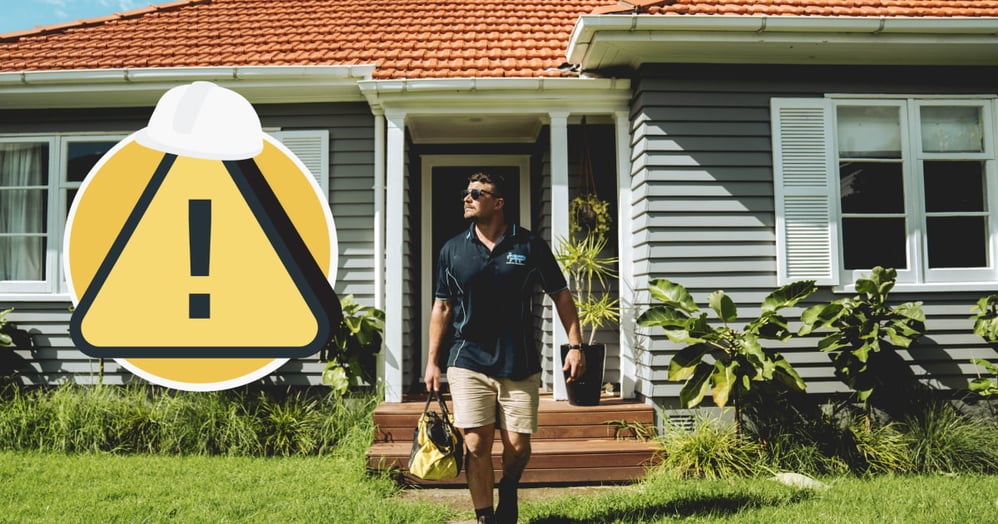Landscaping Health & Safety Policy — Tips For Gardeners & Landscapers
by Team Tradify, April 12, 2023

Table of Contents
Landscaping is a demanding profession. There are long days, challenging conditions, and a lot of activities that can bring health and safety risks. Because of this, it’s important that landscaping business owners and gardening professionals take all measures possible to make the job as safe as they can. Awareness is key when it comes to health and safety — being up to speed on all the risks and knowing your legal obligations are absolutely essential.
Wondering what your staff think about health and safety? Find out with our free Health & Safety Survey!
Short on time? Skip ahead!
- 1. Hazards and solutions
- 2. Health and safety legislation by country
- 🇺🇸 United States
- 🇬🇧 United Kingdom
- 🇦🇺 Australia
- 🇳🇿 New Zealand
- 3. Grow a healthy business with job management software
1. Landscaping health & safety - hazards & solutions
Landscapers and gardeners are exposed to more hazards each day than most people. Because of this, it’s vital for professionals to be aware of the risks and hazards around them, and how to deal with these dangers. Here are some of the most common health and safety risks in the landscaping and gardening industry, and how to stay protected:
Stress
Running a landscaping and gardening business can be an extremely high-stress undertaking. Between meeting customers’ standards, managing staff, and all the office work that comes with the job, stress can add up, causing burnout and mental health strains.
How to avoid stress and burnout:
- Take breaks or holidays when you feel the stress building up. It might seem like you don’t have the time, but coming back to work refreshed will mean greater productivity and better work.
- Get decent job management software to reduce the admin burden. Tradify is a great option that can do wonders for your business management.
Compounding injuries
With plenty of heavy lifting, dragging, digging, and general force required on a daily basis, it’s common to sustain musculoskeletal injuries when gardening and landscaping. While professionals might be tempted to fight through the aches and pains, these can add up to create a significant injury in the long run.
How to stay injury-free:
- Don’t try to out-muscle heavy objects alone - always ask for help.
- Use your tools. If there is a safer, less strenuous way to do something using your tools, then do it.
- Take breaks between physically demanding tasks.
- Stretch, strengthen, and recover as much as possible to keep your body conditioned for physical labour.
Exposure to chemicals
If you use pesticides, herbicides, fertilisers, or other chemicals on the job, then you may be exposing yourself to some serious health and safety risks such as respiratory damage and burns. As with any dangerous substance, these chemicals can be handles safely, as long as should extreme caution is applied.
How to stay safe when handling hazardous materials:
- Read and follow the manufacturer’s instructions carefully.
- Store in a secure area, out of reach of children and away from consumables like food.
- Always wear appropriate PPE such as protective clothing, goggles, and a face mask when handling chemicals.
- Keep a first aid kit, including eye rinses, creams, balms, and bandages close by in case you come in contact with chemicals that can have burning effects.
Slips, trips, and falls
Working outside, in often uneven and slippery conditions, most landscapers are familiar with the risk of slips, trips, and falls. However, it can be easy to overlook just how dangerous this risk is, so it's important to give it the attention it deserves.
How to reduce the risk of accidents:
- Wear appropriate footwear with plenty of grip.
- Take your time when the ground is uneven or slippery. It may be hard to do so when you have a deadline to meet, but remember that you won’t be getting anything done if you’re badly injured.
- Keep some dry towels with you for wiping down slippery surfaces like steps or ladders.
- Use signage and communicate with those around you so that everyone is aware of slip/trip hazards onsite.
Heat or cold exposure
Landscapers and gardeners don’t have the luxury of working inside when temperatures get extreme. Because of this, it's important that professionals know their limits and don’t expose themselves to weather conditions that could be harmful.
How to protect yourself from the weather:
- Know when to call it a day and set safe temperature limits for work.
- Wear appropriate clothing.
- Use sun protection.
- Stay hydrated.
Machinery and equipment
Lawnmowers, chainsaws, axes, sharp spades—the list of dangerous gardening equipment and machinery is a long one. No matter how much experience you have, there’s no excuse for handling equipment in any way that isn’t as safe as possible.
How to put safety measures in place:
- Check local organisations to see if there is safety training available for the machinery you’re using.
- Include a safe-use outline in your employee handbook for new staff.
- Wear appropriate PPE such as steel-capped boots, protective eyewear, and ear muffs.
- Don’t throw yourself in the deep end. Ask for help if you’re not sure how to use something safely.
2. Health & safety legislation by country
🇺🇸 United States
The Occupational Safety and Health Administration (OSHA) oversees landscaping health and safety. They outline specific standards for safe conduct when undertaking landscaping and gardening work such as wearing PPE and undergoing various forms of health and safety training.
🇬🇧 United Kindom
The Health and Safety Executive (HSE) is responsible for ensuring health and safety in the landscaping industry. They have a comprehensive set of requirements for those working in the industry that you can view here.
🇦🇺 Australia
While policies can change state-to-state, Safe Work Australia is the national policy body responsible for landscaping health and safety. Check their website for an outline of the policies that apply to you.
🇳🇿 New Zealand
WorkSafe is responsible for landscaping health and safety in New Zealand. You can view a list of all the health and safety topics and policies that apply to you here.
3. Grow a healthy business with Tradify job management software
As your landscaping or gardening business grows, so does the amount of admin that needs to happen behind the scenes. Keeping track of cleaning supplies, scheduling, client information and invoicing are time-consuming and can quickly take you away from the task at hand.
Specialised landscaping and gardening job management software like Tradify provides an all-in-one solution for your day-to-day processes in one streamlined hub. You’ll have everything from quoting to scheduling, job management to invoicing — all at your fingertips.
For an all-in-one fix that’ll put your day-to-day quoting, scheduling, job management and invoicing processes into one, streamlined system, Tradify is a must-have tool. Try it free for 14 days.
Related articles

How To Set Up a Google Business Profile (for Trade Businesses)

Aussie Electrician Reduces Admin Time by 95%

Squeaky Clean Scheduling for Pro Carpet Cleaning
Give Tradify a go for free!
Save 10+ hours/week on business admin with the highest-rated job management software for tradespeople.
With free one-on-one training and phone support, it's never been easier to get started.



